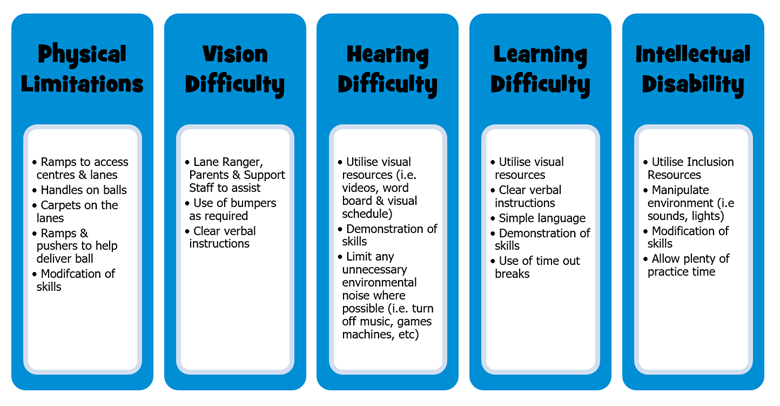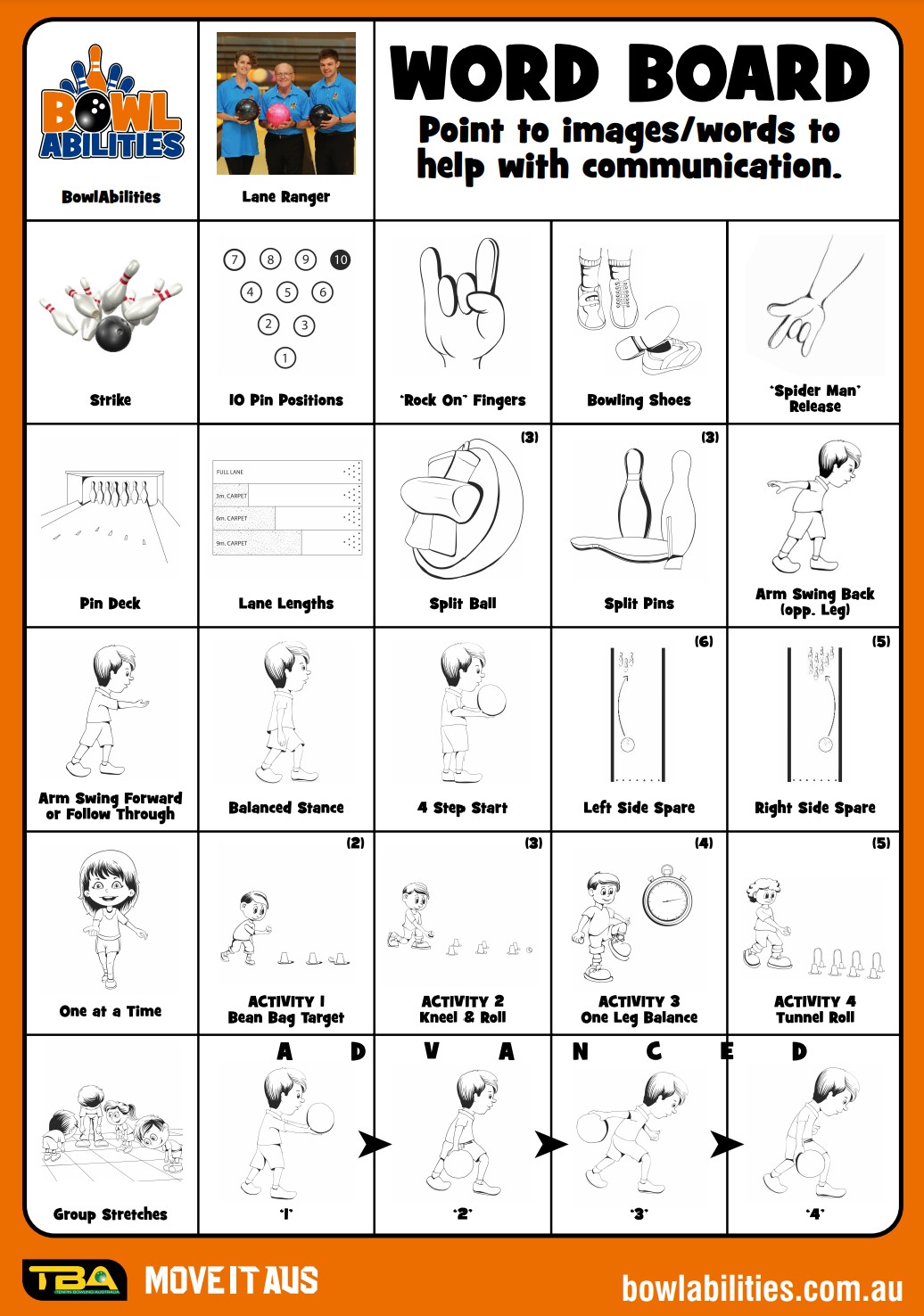Lane Ranger Training – Inclusion & Modifications
EVERY BODY CAN LEARN TO BOWL
INCLUSION
Your participants will come in all shapes and sizes, we want every ‘body’ to enjoy learning to bowl. Therefore you should always try to:
- Respect the individual, learn the strengths of the participant and focus on their ability.
- Create a positive experience by giving feedback nicely, being patient and allowing participants to learn at their own pace.
- Communicate clearly and offer ‘time out’ breaks, remain consistent with the session formats, equipment, lanes and structure where possible.
People utilising the NDIS may be able to include learning to bowl as part of their plan. Learning to bowl is a great way to increase physical activity levels but also teaches other useful life-skills such as communication, cooperation, routine, social inclusion and being able to participate more independently in the community. Centres may also be able to offer the opportunity to practice finance management (purchasing a game, snack), time management and transporting to and from the centre. We’re happy to help participants on a case-by-case basis.
Some of the challenges our participants might present with are listed below – we’ve offered some advice that might support the learning experience;

To create an inclusive program you should up-skill yourself to understand the ability, modify the sport and be the best coach you can. Don’t be afraid to ask your participant (or their carer) “what works best for you?”.
IN THIS SECTION:
- Bowling Modifications
- Program Modifications
- Progression Structure
- Schools
- Groups
- Jason Belmonte’s 2-Handed Bowling

(Middle image above courtesy of Special Olympics Australia)
BOWLING MODIFICATIONS
Using modifications like these are a great way to ensure learning to bowl is achievable for everybody;
RAMPS rolling a ball down a ball-ramp can help with accuracy and projection. Use an assistant, a hand, mouth, etc to push. Wedge-ramps can assist with accessibility up/down steps and platforms at entrance/exit, reception, waiting areas and restroom facilities.

BALL HANDLES make gripping the ball easier. The handle retracts into the bowling ball once released. Ask the centre if they have these on hand

BUMPERS either side of lane to keep the ball on lane. Try to encourage straight delivery technique (Spiderman release) and avoid relying on bumpers unless necessary.

LIGHTER or HEAVIER BALLS most centres will have a range, you may have to ask for them (minimum 6lb’s). Ask staff to explain finger hole sizes and best fit for your participants.
Why can’t I have a lighter ball? In order for the ball return function to work, balls must be a minimum weight. The off lane activities are ideal for building strength.

Ask the staff at your centre to help with any additional modifications including accessibility and supports (i.e. ramps, parking, lanes or leagues), environment adjustments for ambient sound (e.g. turn music down, screens off, games, practice) or use of cafe/restaurant and restroom facilities for break times.
PROGRAM MODIFICATIONS
Bowl Patrol and Bowl Abilities programs have been designed with some program modifications to facilitate the learn to bowl journey of participants. Key modifications of the programs include:
- LANE LENGTHS 9 metre, 6m and 3m carpets on lanes, then full lanes (try for no bumpers)
- Progress only when target score achieved, one level per session
- NEW SKILLS, activities and THEMES each session, holistic learning
- Shorter, 5-FRAME GAMES, score what you knock down on carpet lanes
- Lane Ranger delivered, parent/carer/support worker assistance optional but encouraged
- INCLUSIVE resources (social story, word board and visual schedule) to help communicate

PROGRESSION STRUCTURE
Programs allow for progression based on skill and ability, there are 6 Levels of Achievement.

Participants are required to achieve the target score during either of their two 5 frame games during the session before being rewarded with that colour wristband. Progress to the next level can only occur at the next session, with only one level per session.
Note: *PB = Personal Best score.

For participants returning to the program: keep everyone together for the majority of the session, only at game time can the participant return to the lane length they’d previously achieved, this is optional of course.
We discourage participants skipping levels, however they’re welcome to return to a previous level for practice but should return to their previously achieved level for game time.

Schools

Student and teachers love bowling, Bowl Patrol and Bowl Abilities are the Sporting Schools programs of choice, access to these programs can be free for schools utilising Sporting Schools funding.
- Bowl Patrol is perfect for primary schools
- Bowl Abilities is best for secondary educational support schools
Sporting Schools provides funding for portable lanes, coaching, resources and games in the centre. These programs are also available outside of Sporting Schools funding. Both programs are adaptable to an ‘in-school’ environment.

We like to support teachers to deliver ‘learn to bowl’ experiences to students in an enjoyable and professional way. Find out more www.SportingSchools.gov.au
GROUPS
Bowl Patrol and Bowl Abilities are great for groups of people looking to learn how to bowl in a fun and engaging way.
We can work with the group coordinator to schedule a program at a time and day that suits them, either in the centre or at a location that suits using portable lanes kits.

Some groups who’ve enjoyed their own program include:
- Autism Gold Coast
- Sunnyfield Community Services
- School Holiday or After Hours Care
- Local Councils, Lions groups, Scouts
- ASteen Social Group
- The Junction Works
JASON BELMONTE’S 2-HANDED BOWLING TECHNIQUE
Jason Belmonte is one of the best bowlers ever, he’s an Aussie and he’s our Bowl Patrol ambassador!
What’s different about Belmo is the way he delivers the ball down the lanes… with two hands.
A World Champion multiple times over, Jason is the son of Orange Tenpin Bowling centre owners, who started bowling from a very young age. He still lives there when he’s not travelling the world bowling and winning championships.

We’re very excited to partner with Jason to bring you our 2-handed bowling resource. As a Lane Ranger, you can easily incorporate teaching 2-handed bowling to your participants in either Bowl Patrol or Bowl Abilities.
Check out the double-sided resource and video from Belmo in our Lane Ranger portal – access provided upon completion of this course.
In this video Jason takes us through the basics of the 2 handed technique and provides instructions on how to modify the balance line, one step and four step deliveries for the 2 handed style.
NOTES
- More and more players are bowling with 2 hands, it’s a new and growing trend
- Lane Rangers should be able to teach both options and let the participant choose which feels right for them
- There’s not ‘one way’ of bowling with 2 hands, the number 1 rule is “do what feels natural for you”
- Do not insert the thumb of the bowling hand into the ball, use your opposite hand to take some of the ball weight throughout the swing
INTEGRATING IN TO YOUR PROGRAM:
Session 1 and 2: Balanced Stance Delivery; participants should still stand in ‘balanced stance’ (it’s okay to have the back foot/trail leg crossed a little bit behind). Still do the swing and follow through.
Session 3: One Step Delivery; take a step back from the foul line, hold the ball in your dominant hand, use your supporting hand to steady the front of the ball. Feet together, swing the ball forward from your hip, like a Spider-Man release aiming the arm towards the head pin. Swing the ball back alongside your body to about hip height, at this point and as the ball starts to swing forward again, take one step forward with the opposite leg into the delivery to release the ball.
Session 5: Four Step Delivery; when bowling with two hands, let them take as many steps as they like. Collect the ball from the ball return and deliver as feels right for them. Their cadence (timing of the steps) will develop naturally over time.
What have I learnt? How easy it is to ensure every participant fully enjoys their learning to bowl experience, from modifications to bowling like Belmo.
